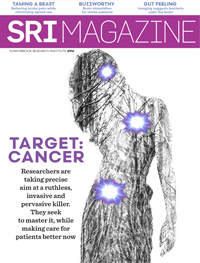Special delivery

Gene therapy is advancing preclinically and clinically, showing promise to treat debilitating diseases like amyotrophic lateral sclerosis and Parkinson’s disease, as well as spinal cord injury and chronic pain.
Getting any therapy into the spinal cord is a problem of access. The spinal cord is protected by a barrier, which, just like the blood-brain barrier, keeps out unwanted agents, but also blocks helpful agents from entering. Moreover, direct injection of therapies carries risks like infection, incorrect needle placement and nerve trauma. Sunnybrook Research Institute (SRI) scientists are pioneering the use of focused ultrasound to deliver gene therapy into the spinal cord.

Dr. Isabelle Aubert, senior scientist in Biological Sciences at SRI, led a study on focused ultrasound guided by MRI to deliver gene therapy across the blood-spinal cord barrier. The team included head of Physical Sciences Dr. Kullervo Hynynen, and musculoskeletal researchers Drs. Meaghan O’Reilly, Cari Whyne and Albert Yee. Under MRI guidance, the researchers injected microbubbles into the circulation of adult rats. When the bubbles reached the target area, the cervical spine or neck region of the spinal cord, the researchers applied focused ultrasound, thereby loosening the tight junctions of the blood-spinal cord barrier.
This loosening resulted in a temporary opening of the barrier to usher therapeutic genes tagged with a coloured protein into the targeted side of the cervical spine. Expression of the coloured protein in 87% of neurons and 36% of oligodendrocytes—cells only in the desired areas—confirmed passage through the blood-spinal cord barrier. This proof of concept study suggests MRI-guided focused ultrasound could be a valuable tool in the delivery of noninvasive gene therapy to promote nerve cell regeneration or improve nerve function in disease or after spinal cord injury.



